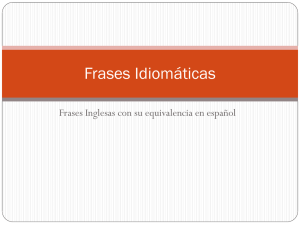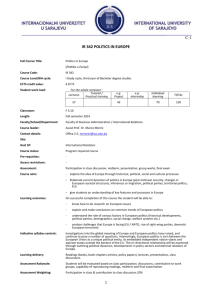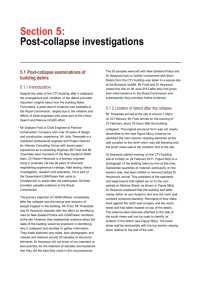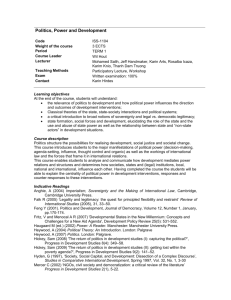Popularity number of printings
advertisement
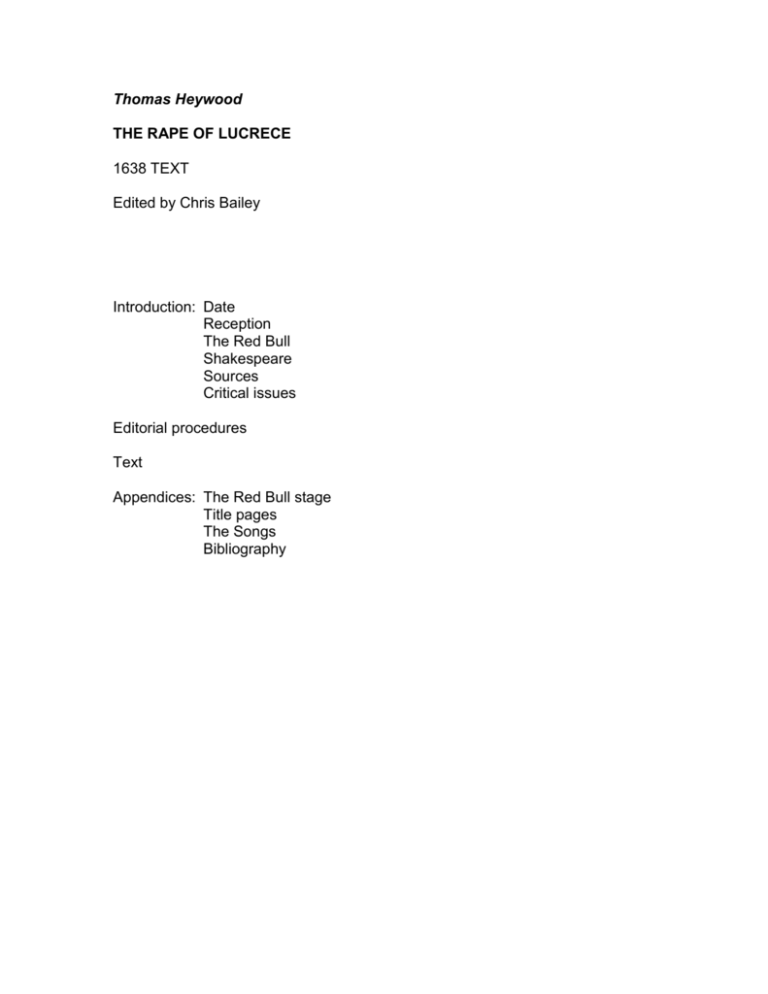
Thomas Heywood THE RAPE OF LUCRECE 1638 TEXT Edited by Chris Bailey Introduction: Date Reception The Red Bull Shakespeare Sources Critical issues Editorial procedures Text Appendices: The Red Bull stage Title pages The Songs Bibliography INTRODUCTION Date Thomas Heywood’s play The Rape of Lucrece was first printed in 1608. There is no record of the earliest performance date. The play lacks clearly topical allusions that might assist a ‘no earlier than’ date to be established. The consensus of most authorities (Chambers, Bentley, Clark) is that the play was first performed in 1606 or 1607, these dates being a matter of hunch or guesswork without the support of decisive evidence. This edition would agree with 1607 as being the likely date of a first performance, basing this estimation on a number of possible references to Shakespeare’s plays, specifically those first performed during the period 1600-1606: see ‘Shakespeare’, below. Reception The printing history of The Rape of Lucrece - impressions in1608, 1609, 1614,1630 and 1638 - attests to the play’s contemporary popularity. It is recorded that the Duke of Buckingham saw the play at the Cockpit shortly before his assassination in 1628 (Clark 1931, 48); the date is interesting as indicating a stage presence continuing some fourteen years beyond its most recent impression, and the venue as showing that the play was felt worth adapting for new performing conditions. (And perhaps had gained in political significance over the twenty years since it first appeared; see ‘Critical Issues’, below.) The play’s popularity, though, was not of a kind such as to find itself reflected in other contemporary works, and a glancing reference in The Knight of the Burning Pestle (act 3, scene 1) is more by way of a cheerful sideswipe than a tribute. The Red Bull The major influence in shaping the style and presentation of The Rape of Lucrece was Heywood’s consciousness that the play would be performed at the Red Bull theatre. Heywood was the principal dramatist for Worcester’s Men, who became Queen Anne’s Men when their patent was granted in 1604, and it was at this time that they shifted their focus of London activity from the Curtain theatre to the Red Bull, which remained their main residence until the death of King James in 1625. When Christopher Beeston, who had taken over the business affairs of the company in 1612, opened the Cockpit theatre in Drury Lane early in 1617, he kept the Red Bull on, switching personnel and selected plays (including the present text) between the two venues. It would be interesting to know more about how The Rape of Lucrece was adapted for a smaller indoor theatre and a coterie audience, because it was initially created for different patrons – spectators, perhaps, rather than auditors. The Red Bull, Curtain and Fortune theatres were situated in a poor area of London, to the north and the east, and the plays performed at these venues reflected popular tastes. Heywood’s play stands at a turning point in the development of theatre in London, the growing distinction between the repertoires of the ‘public’ arena theatres and the ‘private’ indoor venues, a discrimination that extended to the subject-matter and subtlety of the plays on offer: ‘Plays at Blackfriars, Paul’s and, increasingly, the Globe, register a note of discontent with public affairs, while the other adult companies at the Red Bull, Swan, Rose and Hope largely continue to evoke an air of cheerful patriotism and national self-satisfaction’ (Gurr 2004, 186). William Turner in his Dish of Lenten Stuff (1613) expresses a preference for Red Bull plays over those at the Globe, where the players ‘Will teach you idle tricks of love, / But the Bull will play the man’: Turner is ‘praising plays of militant heroics that became known for their noise value and war games as “drum-and-trumpet” fare over the Fletcherian romances and Shakespearean love-comedies that now prevailed in the King’s Men repertory’ (Gurr 1996, 323). Some of the contemporary commentary about the Red Bull should be treated with caution (writers had an obvious self-interest in denigrating the alternative repertoire); nonetheless, an abiding sense of vulgarity, in both audience preference and playing matter, hangs around this venue. In the printed prologue – presumably not included as part of the staged entertainment – to a 1612 Red Bull play, If it be not good, the Devil is in it, Thomas Dekker wrote: A play whose rudeness, Indians would abhor, It fills a house with fishwives, ‘Rare!’ they all roar. It is not praise is sought for now, but pence, Though dropped from greasy-apron audience. (1612, A3v) and John Webster expressed similar feelings about the Red Bull patrons in his preface to The White Devil (1612), written subsequent to his play having failed to please the greasy aprons: ‘Most of the people that come to that playhouse resemble those ignorant asses … the breath that comes from the uncapable multitude is able to poison it …’ (1977, 2). ‘It’ being his play; Webster has been explaining that the first requirement of tragedy is ‘a full and understanding auditory’ and it is not surprising that the subtlety, allusiveness and cynicism of The White Devil did not appeal to the Red Bull auditory. The Rape of Lucrece, however, owing something to the same contemporary vogue for revenge tragedy, was a success, and this is because Heywood, unlike Webster, deliberately adjusted his material to the tastes of his audience – and, it may as well be added, to his own limited range of ability and preferred dramatic style. As the sources section below indicates, Heywood did not hesitate to shape Livy’s story to the ‘drum-and-trumpet’ preferences of his clientele, arranging the tale’s sequence so that it climaxed in scenes of battle, single combat and heroic death. The spectators at the Red Bull enjoyed pageantry, noise and special effects, and Heywood was to go on to show that he was always willing to pander to their inclinations, as in his later ‘Age’ plays; The Silver Age (1613), for example, includes the direction for ‘Thunder, lightnings, Jupiter descends in his majesty, his thunderbolt burning’ (K1r) and for Pluto to enter ‘with a club of fire, a burning crown … and a guard of devils, all with burning weapons’ (K3r). We cannot estimate how and to what extent these, perhaps purely literary, stage directions were realized, but can sense Heywood in The Rape of Lucrece exploring the potential of the Red Bull performing space, as with the use of the rear discovery space (scene 11) and the imaginative requirement for the upper acting area to be split (scene 21). Shakespeare Shakespeare’s poem Lucrece, first published in 1594, was printed for the fifth time in 1607, but it is impossible to tell if the poem’s reappearance stimulated Heywood’s retelling of the story in dramatic form, or vice versa. However, there are several other indications in The Rape of Lucrece that suggest the influence of Shakespeare and especially those of his plays first performed in the years immediately preceding the estimated first performance date of the present text: Macbeth (1605-6): The intensity of Tullia’s ambition and her speech rhythms in the first two scenes of Heywood’s play would seem to resemble those of Lady Macbeth, although there is no direct verbal echo. The comparison ends there. In Shakespeare’s play, the witches arouse a latent ambition in Macbeth’s subconscious and Lady Macbeth then attempts to override his qualms; in Heywood’s play, Tarquin, a rather less subtle psychological creation, is never intended to have qualms, and coolly indicates that he had already been making his own plans (1.53-6). There is little in Heywood’s characterization of Tullia that he could not have derived directly from his principal source, Livy. King Lear (1605-6): In her attitude to her father, Tullia may just as validly be compared to Goneril and Regan as to Lady Macbeth in her attitude to her husband. Aruns’ and Sextus’ love-contest in scene 6 may also be a parodic reminiscence of the opening of King Lear. Measure for Measure (1604): The Clown’s set-piece about the ‘news’ in scene 4 recalls the exchange between Escalus and the disguised Duke in act 3, scene 2 of Shakespeare’s play. The Clown and the Duke share a fondness for dead-end syllogisms. We later find that Heywood’s Clown is named Pompey (7.160), as is the pimp in Measure for Measure. Twelfth Night (1599-1600): Mirable’s attempts to quieten the noisy servants at night (scene 14) evoke Maria’s to silence Sir Toby in act 2, scene 3 of Twelfth Night, down to the echo of the word ‘caterwauling’. Julius Caesar (1599-1600): ‘Brutus, thou art honourable’ (24.88) recalls a famous phrase. Troilus and Cressida (1602). Sextus’ account of Hector’s death seems to be taken from Shakespeare rather than Homer: see note to 24.98-104. Other situations, such as Brutus’ assumption of an ‘antic disposition’, are too common in the drama of the time for a direct correspondence to be confidently affirmed. The influence may have been reciprocal: Shakespeare’s 1608-9 play Coriolanus is another story of tyranny, ambition and an assertive woman (Volumnia) in the early days of the Roman republic. For its sixth printing In 1616, Shakespeare’s poem was re-titled The Rape of Lucrece, the printer perhaps hoping to profit from the popularity of Heywood’s drama. Sources Heywood’s principal source for the story of Tarquin’s rape of Lucrece is Livy’s Ab Urbe Condita – ‘(The History of Rome) from the founding of the city’. Livy’s is a loyalist’s account of Rome, and his frank patriotism and his relish for episodes of bold action painted in primary colours are features of his narrative that have an obvious appeal to Heywood’s temperament. Other possible sources are Shakespeare’s poem Lucrece and accounts found in Ovid and Chaucer. The influence of Shakespeare (see also the section specific to him, above) may have been in initially suggesting the plot source that would serve as the basis for a revenge tragedy in popular mode. Shakespeare’s own source for Lucrece is certainly Ovid and possibly Livy, and there are two episodes, not in the classical sources and first added by him, that are also included in Heywood’s play. One is Shakespeare’s description of Tarquin on his way to Lucrece’s chamber. Tarquin is in mental turmoil: ‘His thoughts are very similar in each case: he welcomes the dark to cloak his deeds; he realises how evil his actions are, that his crime is all the worse for being committed against virtue and beauty, that he harms himself as well as Lucrece, and that he will incur the hatred of Collatine and the nobles’ (Culhane 2005, 25). Shakespeare also invents Lucrece’s encounter with her maid the morning after the violation, which Heywood includes as well, and to which he adds the charming detail of Mirable offering to play her viol. Ovid’s version in Fasti is derived from Livy, and is intended to provide an explanation of the Roman religious anniversary known as the Regifugium, the ‘flight of the king’; he does not add any details to Livy’s account that Heywood might have gone on to use. In his turn, Chaucer worked from Ovid to provide an account in the Legend of Good Women that is perfunctory and colourless by his usual standards; again, there are no unique details that Heywood might have incorporated. So Shakespeare provided a possible inspiration and the idea for two additional scenes; otherwise, Heywood’s account closely follows Livy’s, and Livy must be regarded as his primary source. Heywood includes episodes that are in no source other than Livy, such as the scenes from the Etruscan wars following Tarquin’s exile, and there are touches of detail, such as the references to Turnus (11.23) and to Tarquin’s daughter (6.37-9) that exist nowhere else. Livy’s account of the history of Rome, written from 25 BC to 17 AD, is based, he claims, on sources which we can no longer verify and which he himself admitted were unreliable: ‘There are so many chronological uncertainties in the history of those years … the great antiquity of the events and of the sources does not permit one to make out … what events happened in what year’ (1998, 91-2). In addition, he incorporated speeches and dramatic detail that must have been pure invention. Nonetheless, his history became canonical, the established and indisputable account of Rome’s early years. Livy describes how Tarquinius Priscus, an Etruscan arriviste, flatters and bribes his way into the esteem of King Ancus of Rome and then becomes king himself. Tarquinius also has a favourite, Servius Tullius. He is a house slave who is singled out by a portent and is revealed to have royal qualities and, when Tarquin is assassinated by Ancus' disinherited sons, he adroitly takes over the throne. He is a good king but cannot forestall the resentment of the Tarquins. Tarquinius Priscus' son, Lucius Tarquinius (Tarquin), goaded on by his wife Tullia, the daughter of Servius, usurps the monarchy. Servius Tullius is publicly slaughtered and Tullia rides over her father's body in her chariot. Tarquin is a tyrannical king and is aided in his reign of terror by his sons Sextus and Aruns. Tarquin makes war on neighbouring states successfully, in one case infiltrating Sextus into the city of Gabii and communicating his intentions by means of coded signals. A portent makes him anxious about his future as king and he sends his sons Titus and Aruns to Delphi to consult the oracle. Their cousin Lucius Junius Brutus, who has found it safer under Tarquin’s regime to play the part of a dullard, accompanies them. The oracle proclaims that the next person to hold supreme power in Rome will be the one who first brings a kiss to his mother. Titus and Aruns plot to keep this revelation a secret from their brother Sextus, and to eliminate him eventually. Brutus kisses mother Earth. There is a war against the Rutuli and Tarquin besieges the city of Ardea. In the besiegers’ camp, the noblemen brag about their wives, and Collatine claims that his wife Lucretia (Lucrece) is the purest. The men ride back to Rome to surprise their wives and Lucrece is indeed found to be behaving the most chastely, but this does not prevent Sextus from becoming overwhelmed with lust for her. He returns the next day with the intention of violating her. In her bedroom at night, he threatens that if she resists him he will kill her and leave the body of a dead slave beside her to show that she had been committing adultery of the basest sort. He rapes her and departs swiftly. Lucrece summons her husband Collatine; Valerius, Brutus and her father Lucretius also arrive. She pledges them all to avenge her and then kills herself: 'I absolve myself of wrong, but not from punishment. Let no unchaste woman hereafter continue to live because of the precedent of Lucretia' (Livy 1998, 68). The men swear to overthrow Tarquin and to bring the monarchy to an end. Brutus rouses the people against Tarquin, Tullia and Sextus. Tullia is reviled by the people and flees Rome, and Livy has nothing more to say about her. Sextus is killed, and Tarquin and his two other sons go into exile. The monarchy is at an end, and Brutus and Collatine are elected consuls. Heywood keeps to all of the details of this account (apart from using Sextus to replace Titus' marginal role) until the end, where he introduces wholesale changes. Livy goes on to relate how Tarquin persuades the Veintes, a neighbouring people, to attack Rome, a conflict in which Brutus and Aruns kill each other in combat, and then forms an alliance with the Etruscan king, Lars Porsenna, who lays siege to Rome. It is during this episode that Horatius Cocles defends the bridge over the Tiber - an event about which even Livy is openly incredulous - and Mutius Scevola puts his hand in the fire to convince Porsenna of the resolve of the Roman youth. Tarquin is never overthrown in combat, and eventually dies in exile. At the end of The Rape of Lucrece, Brutus is made sole consul, and after his death, which occurs as a result of single combat with Sextus rather than Aruns, is succeeded by Collatine. Tarquin and Tullia's punishment is to die in battle, Heywood having telescoped an untidy series of events from the Etruscan wars, and having invented some others, in order to provide a thematically and dramatically tidy conclusion in which Sextus' death is the inevitable consequence of his rape of Lucrece, and an exciting series of Livy's more colourful episodes Horatius at the bridge, Scevola in Porsenna's camp - are incorporated to satisfy the Red Bull audience's taste for heroic gesture and for martial noise and movement. Critical Issues The printer’s title page advertisement to an earlier (1599) play of Heywood’s reads: ‘The first and second parts of King Edward the fourth containing his merry pastimes with the Tanner of Tamworth, as also his love to fair Mistress Shore, her great promotion, fall and misery, and lastly the lamentable death of both her and her husband. Likewise the besieging of London, by the bastard Falconbridge, and the valiant defence of the same by the lord mayor and citizens.’ Here there is a double plot, intertwining the fortunes of both King Edward and Jane Shore, and a medley of lively supplementary action. Heywood seldom addressed a topic with only a single purpose in mind, and he never hesitated to mingle genres. He is appealing to the Curtain and Red Bull audiences, for whom form and congruity were secondary to a lively afternoon’s entertainment. The play of Heywood’s which has found most favour with modern audiences, A Woman Killed with Kindness, shows a singleness of purpose and a tight relation between plot and sub-plot which makes it an exception among his works. Modern criticism prizes artistic cohesion and aesthetic value, and these are principles that, even should they have occurred to him, Heywood would have regarded as secondary. The element of variety in The Rape of Lucrece that grates with the modern reader and seems a violation of propriety is the inclusion of the songs. Barbara Baines sums up the representative attitude: ‘Valerius’ songs in the midst of the tragedy violate every principle of artistic decorum and good taste’ (1984, 104). Heywood had precedents for mixing tragedy with music as in, for example, Marston’s Antonio’s Revenge and The Malcontent, but there is no other purported tragedy that goes as far in incorporating music as The Rape of Lucrece – by the time of the present, 1638 impression, the number of songs had expanded from an initial ten in the 1608 printing to twenty-one (see Appendix 3), distorting, for the modern critic, any possibility of artistic cohesion in the play. It is the continued aggregation of songs, as impression follows impression, that gives away Heywood’s motives; the songs were popular with the audience, and so he gave them more of what they wanted, as Bamford observes: ‘The inclusion of the bawdy songs was a shrewd and successful theatrical move’ (2000, 73). The impetus may not have been Heywood’s alone. The introduction to the ‘Back matter’ refers to ‘these few songs, which were added by the stranger that lately acted Valerius’. It seems likely that the part of Valerius was specifically written for a guest or temporary actor (‘stranger’) with singing ability, who was then, as a star turn, allowed a degree of licence to insert his own favourites, material which Heywood later incorporated into the text. One can discern what may have been originally a valid artistic purpose. Valerius’ songs are part of the Roman noblemen’s design, as expressed by Collatine (6.173-193), to assume a variety of dispositions, antic and otherwise, in order to avoid unwelcome attention in a dictatorship that is characterized by paranoia and violence: as Brutus puts it, ‘Is it not better to sing with our heads on, than to bleed with our heads off?’ (6.268-9). It is then feasible to construe an intent in the choice and the placing of some of the songs, as with the lovely ‘Pack, clouds, away and welcome day’ (scene 18) of which Baines (1984, 111) avers: ‘The juxtaposition of Lucrece’s tragic night and following morning with this joyous aubade achieves a fine pathos and a poignant irony. The disparity between Lucrece’s reality and the idealized world of the song underscores the tragic alteration in the private life of the heroine.’ This overlooks the fact that this song was not a part of the play’s original design, being added only in 1630, and that a number of the songs are not poignant counterpoints but are bawdy singalongs. Again, there may have been an element of conscious design in that the songs could be interpreted as signifying ‘the ills of Rome’ (Culhane 2005, 36) under Tarquin’s dispensation and the moral turpitude of the noblemen in retreating under cover instead of fulfilling their moral obligation to take direct action, which they fail to do until provoked by Lucrece’s violation. While the songs may sometimes be potentially effective in reinforcing or contrasting a specific dramatic situation, there are points in the play where they completely overwhelm its immediate dynamic: ‘The degree of failure in the experiment lies not in the idea but in the carelessness of its execution. There are simply too many songs’ (Baines 1984, 111). A particular problem rests with the inexpressibly vulgar catch ‘Did he take fair Lucrece by the toe, man’, at the end of scene 18. This catch is a part of Heywood’s original intentions for the play rather than being a later interpolation. Some creaking dialogue introduces the idea that the Clown has to sing the news of Lucrece’s rape rather than delivering his information more conventionally. One can appreciate Heywood’s problems in writing this episode for the Clown. The Clown has been established as a cheerful low-life, and is now called upon to deliver profoundly shocking intelligence. Jonathan Bate notes a similar situation in Titus Andronicus, where ‘the first reaction to the rape is a series of jokes’ (1995, 10) and comments on a later outrage, Titus’ hysterical laughter on receiving the heads of his two sons, that ‘human nature does not obey dramatic decorum’ (1995, 11). Modern decorum expects the register of grief to take precedence over that of crude comedy, and in the present instance Lucrece has not yet been given the opportunity to voice her distress. Ian Donaldson remarks that Heywood has allowed his audience ‘a hearty response to those parts of the story which may have seemed to them implausible, titillating, or overwrought’ (1982, 89). By prioritizing the popular demand, Heywood has introduced an intolerable (for a modern audience) strain into the story - one would have thought it vital that the Roman noblemen take the rape seriously as it is to be the trigger for their insurrection. In the event, when Lucrece tells her story in scene 19, Heywood has queered his pitch; the noblemen fail to deliver a significant emotional response, and fall straight to discussing the political implications of Sextus’ conduct. Heywood insisted that his guiding principle was to write for a popular audience. He expressed this in An Apology for Actors: ‘Plays have made the ignorant more apprehensive, taught the unlearned the knowledge of many famous histories and instructed such as cannot read’ (1612, G2v). He was impeccable in following classical and medieval doctrines about the purpose of art being both to delight and to instruct. The instruction should carry a clear moral and social message, to which end he specifically cites the present story: ’Art thou inclined to lust? Behold the falls of the Tarquins in the rape of Lucrece … We present men with the ugliness of their vices to make them more to abhor them’ (G1r). The past is to be used for didactic purposes, both private, as in the previous quotation, and public, because the two are indissolubly linked: ‘The private virtues of the individual determine the well-being of the commonwealth’ (Baines 1994, 8). The end product of private rectitude is political conformity; plays should teach ‘subjects true obedience to their king, to show people the untimely ends of such as have moved tumults, commotions and insurrections, to present them with the flourishing estate of such as live in obedience, exhorting them to obedience, dehorting them from all traitorous and felonious stratagems’ (1612, E3v). As two of Heywood’s earliest plays (The Four Prentices and If you know not me, you know nobody) demonstrate, he was at heart an Armada-era Elizabethan, a loyalist and patriot, and his reaction to a change of monarchy was to express the continuity between the old regime and the new rather than to expose the differences. On the face of it, this makes the choice of the Lucrece legend puzzling for such a conservative; the story involves the overthrow of a monarchy in favour of a republic, and this is an aspect that Heywood’s source Livy, from his own perspective in later republican Rome, was mindful to emphasize: ‘Livy’s positive depiction of a republic was not easily assimilated in a monarchy like England’ (Culhane 2005, 31). Heywood solves the problem by subtly adjusting the emphasis of the original tale. Tarquin is an usurper and so not a legitimate ruler, and Heywood is scrupulous in giving Brutus divine blessing (the visit to the oracle) for his subsequent actions. The divinely appointed order is not to be disturbed. Heywood goes out of his way to have Brutus remind us of this sanction at the start of the final series of conflicts Now, Sextus, where's the oracle? When I kissed My mother earth it plainly did foretell My noble virtues did thy sin exceed: Brutus should sway, and lust-burned Tarquin bleed. (20.34-7) Brutus has unhistorically been elected single consul (there were always two in ancient Rome) and refers to himself as a king (‘royal Brutus’, 20.33). He is succeeded by another single consul, Collatine. At the end of the play, Rome is a monarchy in all but name, an impression Heywood reinforces by bringing back King Lars Porsenna on the final page to bestow his royal imprimatur on the new order. In the final analysis, it may be that those elements that Heywood obtruded on his original material – the songs, the bawdiness, the appeals to popular sentiment and patriotism - backfired on him. They ensured that The Rape of Lucrece’s popular appeal was such that it had an extended life in the theatre. This story of a dissolute monarchy, a story that Heywood had fashioned with loyalist intent at the start of the first Stuart reign, may have been interpreted rather differently by a more questioning audience as it continued its long stage presence towards the end of the second Stuart reign. Editorial procedures Textual decisions This edition is based on the fifth impression of the play, printed in 1638. While there are slight variations between the earlier 1608,1609, 1614 and 1630 impressions, these are the result of compositor errors and corrections (see, for example, the note to 3.23) rather than authorial revisions. In the 1630 impression, three new songs have been inserted, but the text is otherwise largely unchanged. The 1638 impression is offered to the reader as being ‘the copy revised’. A further five songs have been inserted, and there is evidence of authorial, rather than compositor, emendation. It is not the purpose of the present edition to offer a detailed comparison between the variants in all five impressions. The 1608 printing has been consulted as a ‘base’ text, representing the first four impressions, and all significant differences between that text and 1638 have been recorded; these variations are often illuminating in themselves and so have not been compiled as a separate list of collations but have been incorporated in the general Notes. Act and scene divisions In their printed versions, many of Heywood’s plays are presented in five acts, with scene sub-divisions. Others, such as A Woman Killed with Kindness and the present play, run continuously, with no indication of divisions. For ease of reference, this edition has been presented in numbered scenes, a new scene occurring when the stage directions indicate that the stage is notionally clear. No attempt has been made to impose a five-act structure. Stage directions Heywood’s stage directions are frequently expressive, and so have been left unchanged; editorial additions to the stage directions have been made in square brackets. In the Notes, stage directions are identified by the number of the line they immediately precede. Spelling has been regularized and modernized. Punctuation has been modernized. A characteristic of Heywood’s style, in both verse and prose, is to write in series of loosely coordinated clauses. The punctuation in the original to distinguish separate clauses is usually either a comma (where the modern reader would expect something stronger) or, very occasionally, a full stop when the modern reader would expect the sense to continue; this edition has frequently adopted the semi-colon as an acceptable modern compromise: Clow. Soft, soft not too loud, imagine we were now going on the ropes with egges on our heeles, he that hath but a creking shooe I would he had a creeke in is neck, tread not too hard for disturbing Prince Sextus. (14.1-3) Clown Soft, soft, not too loud; imagine we were now going on the ropes with eggs on our heels; he that hath but a creaking shoe I would he had a creak in his neck; tread not too hard for disturbing Prince Sextus. Final –ed and ‘d: past tense and participal forms of verbs have been left as originally printed. Where the scansion requires pronunciation that diverges from modern usage, this is indicated by a grave accent: My father in my swathèd infancy (1.52) Elision Elided forms are left as originally printed. Not all elisions are indicated in the original printing, and sometimes these will need to be provided by the reader: I have sounded all the peers and senators (1.54) (I’ve sounded all the peers and senators) Even in my death, of husband, father, friends (19.115) (E’en in my death, of husband, father, friends) Verse and prose The iambic line has been presented as such wherever possible, so that the original Hor. I would I were no Romane. Sce. Cocles why? becomes Horatius I would I were no Roman. Scevola Cocles, why? (4.1) The printed text is generally clear is to whether it should be in verse or prose Occasional passages printed as prose or as irregular verse have been regularized, as at 19.123-5: All What shall we do Lords? Bru. Lay your resolute hands upon the sword of Brutus, Vow and sweare, as you hope meed for merit from the Gods In this edition, this has been presented as: All What shall we do, lords? Brutus Lay your resolute hands Upon the sword of Brutus; vow and swear, As you hope meed for merit from the Gods Heywood follows the conventional discriminations between verse and prose; noble characters speak in verse, except for their more transactional exchanges; Brutus speaks in prose when in ‘antic disposition’; the low-life Clown speaks in prose.

